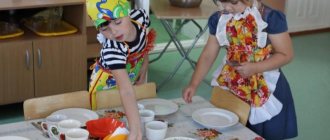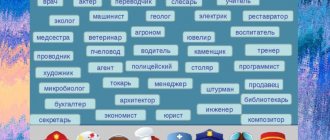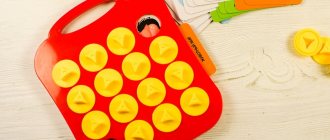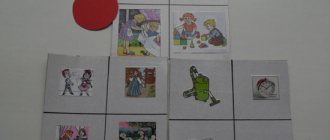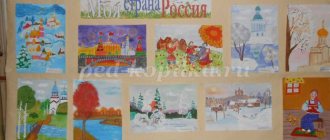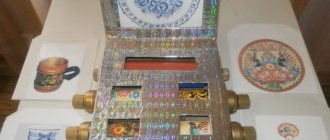Didactic games on labor education for children 3-4 years old
The game “Who can’t do without them?”
Target.
To consolidate children's knowledge about materials, tools and equipment needed by people of different professions.
Progress of the game:
The teacher names the item, and the children name the profession of the person who needs it. For example: a syringe, a control panel, scissors, flour, a garden sprayer, a telephone, a milking machine, a stretcher, a plane, a wheelbarrow, a police baton, a drill, an electrical cable, a nail, a roll of wire, a cash register, a postman's bag, a roll of wallpaper, a cash register, a pencil, brush, tray, bell.
Didactic games
on labor education
for children 5-7 years old
1. “Who knows and can do this?”
Goal: to expand children’s ideas about what knowledge and skills people of different professions should have.
Knows children's poems, tells fairy tales, plays and walks with children... a teacher. Plays the piano, knows children's songs, teaches singing, dancing, plays musical games with children... music director. Knows the human body, can provide first aid, knows how to recognize and treat diseases... a doctor, etc. 2. “Who does this?”
Goal: to train children in the ability to determine the name of a profession by the names of actions.
Cuts, styles, washes, combs, dries... hairdresser. Soaks, soaps, washes, shakes, dries, irons... the laundress. Packs, weighs, cuts, wraps, counts... the seller. Cleans, washes, fries, cooks, cooks, salts, tastes, feeds... cook, etc. 3. “Who does what?”
Goal: to expand and clarify children’s ideas about the work (labor operations) of people of different professions.
The janitor sweeps, cleans, waters, rakes... The music director sings, plays, dances, teaches... The junior teacher (nanny) washes, cleans, wipes, covers, dresses, reads... etc. 4. “Correct the mistake”
Goal: to teach children to find and correct mistakes in the actions of people of various professions.
The cook treats, and the doctor cooks. The janitor sells, and the seller sweeps. The teacher cuts the hair and the hairdresser checks the notebooks. The musical director does the laundry, and the laundress sings songs with the children... etc. 5. “For a person in what profession is this necessary?”
Goal: to expand children’s understanding of the items necessary for a person in a certain profession. Scales, counter, goods, cash register... - to the seller. Broom, shovel, hose, sand, crowbar, snow blower... - to the janitor. Washing machine, bath, soap, iron... - to the laundress. Comb, scissors, hair dryer, shampoo, hairspray, hair clipper... - to the hairdresser, etc.
6. “Who needs what for work?”
Goal: to expand and clarify children’s ideas about the objects of the surrounding world (materials, tools, equipment, etc.) necessary for work by people of different professions.
For the teacher - a pointer, textbook, chalk, blackboard... For the cook - a pot, frying pan, knife, vegetable cutter, electric oven... For the driver - a car, spare tire, gasoline, tools... For the art teacher - brushes, easel, clay, paints... etc. 7. “Clap your hands if it is necessary for ... (name of profession)”
Purpose: to exercise the ability to relate words and phrases to a specific person’s profession.
Children are invited to clap their hands when they hear a word or phrase that is suitable for a profession, for example, a doctor: haircut, cold, scales, ambulance, sewing machine, seeing patients, fashionable hairstyle, washing powder, white coat, snowblower, etc. . 8. “Who can name the most actions?”
(with a ball) Purpose: to teach children to correlate the actions of people of different professions.
The teacher names a profession and, in turn, throws the ball to the children, who name what a person in this profession does. 9. “Continue the sentence”
Purpose: to exercise the ability to complete sentences using words and phrases related to a person’s specific profession.
The cook cleans... (fish, vegetables, dishes...), The laundress washes... (towels, bed linen, bathrobes...). A teacher in the morning with children...(does exercises, has breakfast, conducts classes...) A janitor in the yard in winter...(shovels snow, clears areas, sprinkles sand on paths...), etc. 10. “Who is in the photo?”;
“Find and tell” (based on photographs) Purpose: to consolidate children’s ideas about the work of kindergarten staff.
Children are asked to name a kindergarten employee (from a photograph) or select the desired photograph and tell about this person: what is their name, what room does they work in, what is they like, what does they do? 11. “Let’s draw a portrait” (speech)
Purpose: to teach children to draw speech portraits of kindergarten employees. Children are asked to compose a descriptive story (Who is this? What does he look like? What does he do? Etc.) about a kindergarten employee according to a model, plan, algorithm, using photographs, mnemonic tables.
The purpose of the didactic game “Who needs what”
The goal is to become familiar with professions and their associated attributes.
Tasks:
- consolidation of names and ideas about professions;
- familiarization with objects and tools used by specific specialists;
- developing the skill of relating work wardrobe to professions;
- fostering a respectful attitude towards work;
- strengthening cognitive interest;
- development of memory, speech skills, concentration, ability to think logically.
Didactic game “What a firefighter needs”
The game, intended for middle school preschoolers, expands their understanding of the work of a firefighter. The lesson requires an image of a firefighter, as well as pictures depicting the attributes and tools that this worker cannot do without: a helmet, a fire truck, a fire extinguisher, a box of sand, etc. You also need to make several pictures with objects not related to firefighting.
The player looks at pictures of objects and selects those that the fireman uses. He must explain in detail the purpose of each tool.
Didactic game “Who needs what for work”
The game introduces preschoolers to specialists in various professions: policeman, builder, fireman, doctor, school teacher, salesman, cook, kindergarten teacher, artist, traffic controller.
For the lesson, you need to prepare large A5 size cards depicting representatives of the above professions. You also need to make smaller pictures, approximately 10x10 cm, depicting the objects and tools used by the represented specialists. The number of pictures is arbitrary.
You can play in several ways:
- Game for one player or a subgroup of 1-3 people. The presenter shows a card with a picture of the employee. Players select pictures with the tools that this specialist uses and give reasons for each of their choices. In a subgroup lesson, the player who makes the fewest mistakes wins.
- Game for a group. The presenter distributes cards with representatives of professions to the players. Then he shows pictures of objects one by one. The child, having guessed that this instrument is suitable for his specialist, picks up his card and explains the choice in detail.
- Individual game. The player takes any card he likes depicting an employee and talks in detail about the profession. Next, he selects pictures of the tools that the described specialist uses.
Work clothes
For this lesson you will need paper cut-out images of a boy and a girl, different types of work wardrobe, as well as corresponding professional tools.
The presenter explains that the paper dolls are going to work, and you need to help them choose a suitable wardrobe. Then he places a picture of a tool next to each doll, from which the players must guess what item of clothing is needed. Children dress dolls and name their profession. And so for every work clothing.

